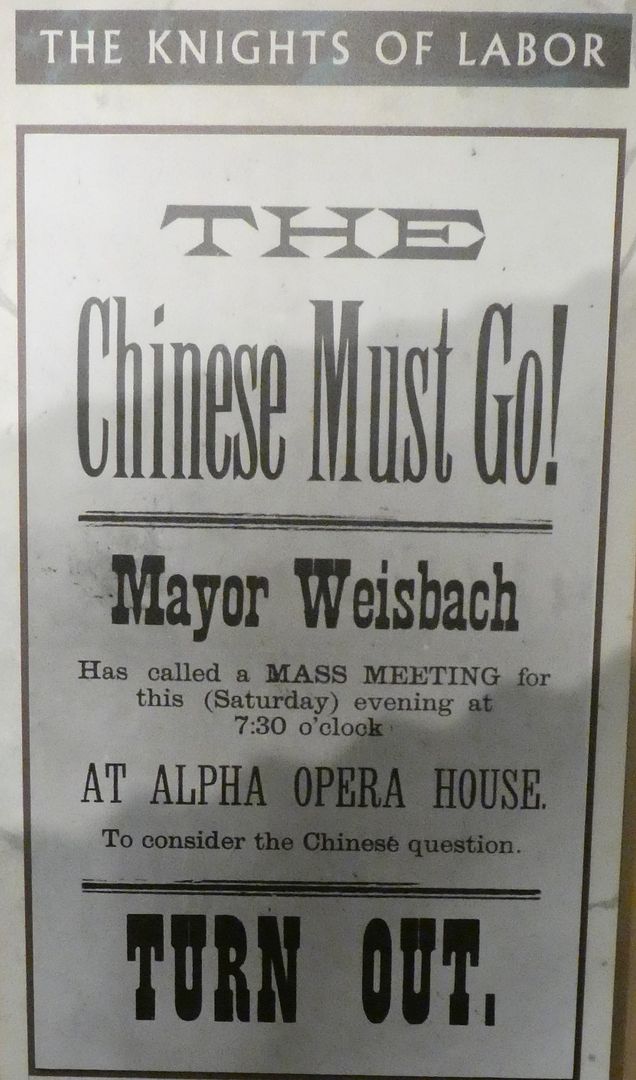The Washington State History Museum in Tacoma has a display on labor unions.
The union newspaper was an important part of the union movement. The Knights of Labor established the first labor reading room and established the first journals advocating social reform.
According to the display:
“The most colorful labor journal is probably the Industrial Worker, in which Wobbly writers and cartoonists zestfully attack tycoons, financiers, and bourgeois moralists.”

The Knights of Labor (KOL) was the first nationwide industrial union. According to the display:
“Its broad appeal suited Washington’s roving workforce. Calling for an eight-hour day, equal pay for women, and the elimination of child labor, the Knights found recruits among miners and timberworkers.”
 While the union opposed discrimination against African-Americans it built its support with anti-Chinese agitation.
While the union opposed discrimination against African-Americans it built its support with anti-Chinese agitation.
The KOL collapsed when a series of strikes against mining companies failed.
 For David Beck unionism was not a social cause, but a service for maximizing prophets for business and labor alike.
For David Beck unionism was not a social cause, but a service for maximizing prophets for business and labor alike.
According to the display:
“As the nation’s most powerful labor leader, he did more than anyone else to bring the labor movement into the mainstream of corporate America.”
In 1905, the Industrial Workers of the World (IWW) was formed in Chicago. Big Bill Haywood, a leader of the Western Federation of Miners, opened the meeting using a piece of board as a gavel. He stated:
“We are here to confederate the workers of this country into a working-class movement that shall have for its purpose the emancipation of the working-class from the slave bondage of capitalism.”
In his book A People’s History of the United States, Howard Zinn writes:
“The IWW (or ‘Wobblies,’ as they came to be called, reasons not really clear) aimed at organizing all workers in any industry into ‘One Big Union,’ undivided by sex, race, or skills.”
Howard Zinn also reports:
“The IWW people were militant, courageous. Despite a reputation given them by the press, they did not believe in initiating violence, but did fight back when attacked.”
In an attempt to stop the IWW, many towns passed ordinances prohibiting “street meetings.” In Spokane, Washington in 1909, 600 Wobblies were arrested and jailed for speaking out. Several died in jail due to the harsh conditions.
In 1916, the sheriff in Everett, Washington, organized a group of about 200 armed vigilantes who fired on a boatload of Wobblies, killing five and wounding 31.
In 1919, the IWW came up with the idea of a general strike and for five days, 100,000 workers in Seattle staged a walkout. While the strike was peaceful, 39 Wobblies were jailed as “ring-leaders of anarchy.” The mayor of Seattle characterized the strike this way:
“The so-called sympathetic Seattle strike was an attempted revolution. That there was no violence does not alter the fact.”
By the 1920s, the IWW was destroyed. Howard Zinn reports:
“The strikes were beaten down by force, and the economy was doing just well enough for just enough people to prevent mass rebellion.”












Museums 101
Museums 101 is a series of photo tours of various museum exhibits. More from this series:
Museums 101: An Outdoor Collection of Farm Equipment (Photo Diary)
Museums 101: The Western Room in the Fort Dalles Museum (Photo Diary)
Museums 101: Japanese glass fishing floats (photo diary)
Museums 101: Newspapers and Telephones (Photo Diary)
Museums 101: Old Time Education (Photo Diary)
Museums 101: The Blacksmith Shop at Fort Vancouver (Photo Diary)
Museums 101: The Rosyn Coal Mine (photo diary)
Museums 101: Farming in Washington (Photo Diary)


